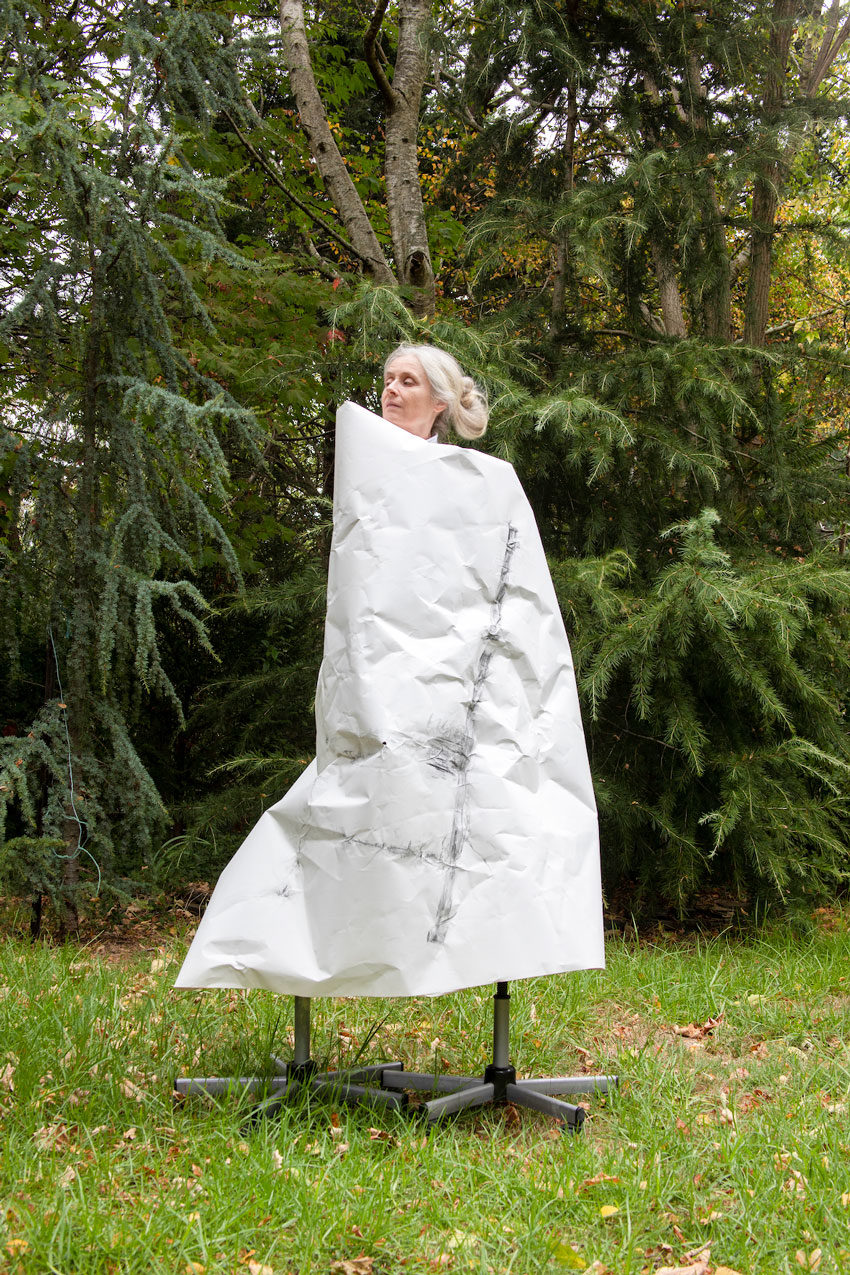Cynthia Schwertsik has confirmed her presence in Adelaide’s contemporary art scene through a series of performances involving the use of everyday objects in unconventional ways.
In Peri Urban Progress (2018) the artist circumnavigated the boundaries and fence lines of Adelaide suburbs using two chairs as ‘stilts’. In Mutton Cove (2018) the artist traversed in a similar manner a conservation reserve on the Le fevre Peninsula by the Port River.
These performances incorporated the primary elements that have come to characterise her practice. Prominent in this mix is absurdity. In the traditions of a Monty Python sketch (an inspiration for Schwertsik) a person (the artist) travelled with great purpose across a deserted landscape using two chairs as stepping devices. That it made absolutely no sense was of course the whole sense of the exercise.
The chairs were domestic props – another strategy used often by the artist, who regularly co-opts items from within and around the home to use as fellow actors in her little dramas. Costuming matters. The artist favours drapery, outsized men’s suits and the like. This casts the ‘actor’ as a kind of low-rent shaman, even a Chaplin-esque tramp. There is always some reference to nature – often in proximity to urban or industrial developments. It is not easy to pigeon hole Schwertsik along the lines of ‘environmental activist’, ‘feminist warrior’, ‘Beuysian ironist’ or free-range performance artist.
There are matters dear to her heart, including care of the natural environment, species extinction, constrictive gender roles and so on. These determine to some extent the staging and narrative of her performances. But there is an intuitive spirit that animates her work and gives it a playful, ambiguous character.
Performance art of the 1960s and 1970s favoured theatrical or staged events in the presence of an audience. Schwertsik is from a subsequent generation that co-opted photography and video as a means of initially documenting then amplifying the conceptual scope of performance-based practice. Schwertsik’s recent video works have resulted from a collaboration with videographer Jennifer Hofmann.
This alliance between actual events and their (edited) documentation/recreation accommodates the artist’s understanding of art as something that occurs within constantly negotiated spaces. “Where is the essence of art held?” she asks. “In the object, in the mind, or in-between?”
Through the medium of video, the artist is able to play with time and space, inviting the viewer to share her sense of being always in this inbetween space. In The Stacks, for example, which involved Schwertsik standing at her kitchen sink, piling plastic recyclable containers against the window, the viewer (with the aid of close -focus shots) becomes the artist. During her Sauerbier House residency, Schwertsik transformed her studio into a performance space. The resulting video shows the artist moulding sheets of paper against her body to create a series of carapace units that eventually ‘consume’ her body.
 Cynthia Schwertsik, Bird Life, from the series Future Incarnations (2019), which appeared in last year’s SALA Festival exhibition The Scene Is The Seen at Holy Rollers Studio
Cynthia Schwertsik, Bird Life, from the series Future Incarnations (2019), which appeared in last year’s SALA Festival exhibition The Scene Is The Seen at Holy Rollers Studio
This sensory, seemingly instinctive behaviour is what Schwertsik sometimes describes as a ‘check point’ – a strategy for suddenly disrupting the normality and predictability of everyday life. The artist describes this as feeling the need “to double-check [her] presence through touch, to bridge the gap between visual appearance and the kinetic experience of being alive”.
Art writer Fulvia Mantelli describes Schwertsik’s process-driven practice as “underpinned by a philosophy of art as action… She perceives that passivity leaves us vulnerable to manipulation and dependent on assumptions about the places we occupy”.
The action of standing on her head has become a go-to gesture which has the connotations of ‘turning the world on its head’. Schwertsik describes it as “a way of urging us to take our heads out of the flat world of ‘brainy’ screens made only of pixels and connect with the natural biosphere that more importantly defines what and where we are”. This strategy is evident in one of the Sauerbier videos, and in still photographs that capture moments of Schwertsik’s engagement with Sauerbier House’s dune and estuary settings.
The video spectacle of a pair of legs rising out of the tidal reaches near Sauerbier House, or out of the nearby dunes , is comic. The hook Schwertsik has embedded in the gag is the resemblance these silhouetted shapes have to birds that migrate to the area from the northern hemisphere. So, smiles all round and then the ‘check’. Birds like these – what eventually is their fate?
We live today in a world where anything can be art, but not everything is art. Performance-based art practice, like Cynthia Schwertsik’s, is a reminder that acting on this principle, despite the inspiration of Dada, the Situationist International, Fluxus, the Happening movement of the 60s and 70s, and Adelaide-based ‘post-object’ debates and projects of the late 60s to mid 80s, is a hard and, at times, lonely journey. But it can be fun – serious fun. And no-one who embarks on it, as Schwertsik exemplifies, will ever take daily existence for granted.
John Neylon is an award-winning art critic and the author of several books on South Australian artists including Hans Heysen: Into The Light (2004), Aldo Iacobelli: I love painting (2006), and Robert Hannaford: Natural Eye (2007).
Related Article
Meet Your Maker: Cynthia Schwertsik
Get the latest from The Adelaide Review in your inbox
Get the latest from The Adelaide Review in your inbox